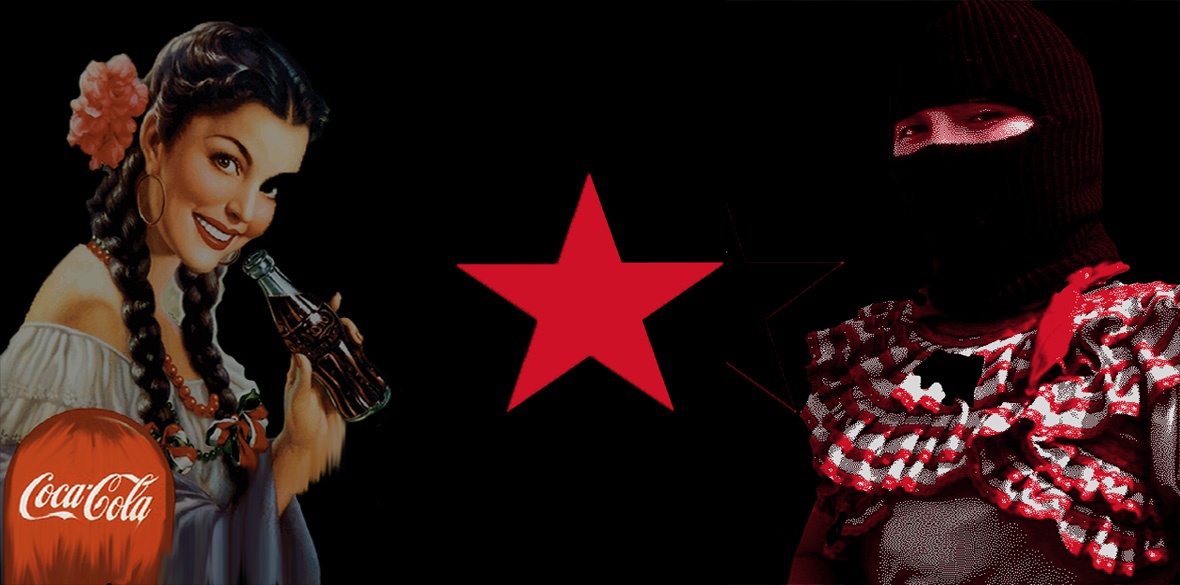This is the last article you can read this month
You can read more article this month
You can read more articles this month
Sorry your limit is up for this month
Reset on:
Please help support the Morning Star by subscribing here
THE Ejercito Zapatista de Liberacion Nacional, EZLN (Zapatista Army of National Liberation) is, more or less, the same age as I am. In 1994, two years after Francis Fukuyama prophesied the “end of history” and chronic renewal of Western liberal democracy, a body of mostly indigenous farmers from the Mexican state of Chiapas, led by a radical university professor, attempted to keep history afloat, at least for a while.
Though their imprint on Mexican politics has been dwarfed over the past two decades by the ascendance of the various narco-warlords, the EZLN embody a resounding refutation of globalised, corporate hegemonies and their branding, their holding-out against the Mexican army, their sustained control of Chiapas territories, goes to show how transformative a focused strategy of civil resistance can be.
Most Mexicans know two things about the Zapatistas. Firstly, that they aren’t easily pleased — the EZLN continues to criticise successive governments, including the current Obrador administration, for ignoring environmental issues.
Secondly, they don’t like visitors — particularly guero (non-American white) tourists like myself: the majority of sympathetic metropolitan chilangos (residents of Mexico City) and Tapatios (Guadalajara) tend to voice their support for the EZLN by simply staying out of their way.
Those who did opt to visit, however, told me the best point of access was San Cristobel de las Casas (a birthplace of the Zapatista revolt and now something of a tourist trap).
To understand where the Zapatista mentality sprang from, you must first understand the 1991 revision of Article 27 (a section of the Mexican constitution protecting indigenous land-holdings from privatisation) and the 1994 North American Free Trade Agreement (Nafta), between Mexico, Canada and the US. This agreement turned North America into a trilateral trade bloc, with US corporations geographically, economically and conceptually at the centre of things. Suddenly, while independent Mexican farmers were gradually priced out, US brands were free to cultivate apathetic monopolies all over Mexico.
Let’s take Coca Cola for example. After Nafta, Coca Cola was allowed to essentially drain the central Chiapan reservoir, extracting 300,000 gallons of water per day for their plant and, in doing so, massively exaggerating the price of water in the region as well as leading to a 30 per cent spike in the mortality rate from diabetes.
Chiapas now consumes more Coca Cola than any other state, in a country that consumes the most Coca Cola, per capita, in the world — it isn’t unusual for a child in Chiapas to drink Coca Cola before it can walk.
The brand has even embedded itself in the spirituality of the indigenous peoples; mystic church ceremonies frequently use Coca Cola in their rituals, with black-clad priests downing copious amounts of the stuff before sacrificing a chicken. It’s also exchanged as currency amongst campesinos in impoverished rural communities.
The taxi from the airport climbs right past these rural communities and almost a kilometre in altitude before depositing the rider at the centre of San Cristobal, just off the zocalo (the main square).
It was here that sub-commandant Marcos — the uncompromising revolutionary and professor I mentioned earlier, frequently pictured astride a stallion, with a pipe poking out of his black balaclava — led a small rebel force to free 230 indigenous prisoners and destroy land records in an avalanche of paperwork thrown from the balconies of the government office — then dissolve back into the Lacandon jungle before the army could arrive.
Over the next 12 days, more than 300 people would be killed in the revolt before Salinas’ Institutional Revolutionary Party (PRI) decided on a ceasefire. After the peace agreement, Zapatista forces refused to disarm and set up “autonomias” (self-governed autonomous villages) laid out and protected in a grouping commonly referred to as “un caracol” (a “conch” or “snail),” all spiralling from one central hub.
They have since not only provided a haven for indigenous groups, but been one of the loudest international champions of indigenous rights (Mexico is home to 10-12 million indigenous peoples) and remained outspoken voices against global corporate hegemonies, sexism, racism, neoliberalism and cultural imperialism.
In a 1993 interview with Kerry Appel of “Cafe Rebellion,” Subcomandante Marcos put it this way:
“I’m not referring only to the Latin American Indians but also to those of North America and to the ethnic groups and social groups that are in the rest of the world, the ones called minorities.
“I’m referring to indigenous people, migrants, homosexuals, lesbians… the youth, the women. Although difficult to categorise as minorities, they are treated as minorities that need to be done away with in different forms, sometimes by police persecution, sometimes by war…”
Over the last 10 years, many “autonomias” decided to open themselves up, in a limited sense, to Western tourists and, apparently, it wouldn’t be unusual to spot tourist boards in Tuxla Gutierrez and San Cristobal offering trips to “visit the Zapatistas.”
However, over the last couple of years the tourism must’ve got out of hand and access to Zapatista territory was more thoroughly vetted — though, according to most Chiapans, sympathetic taxi drivers still occasionally ferried people to a village called Oventic, one of the few still open to visitors.
I managed to track down one of these taxi drivers who first told me the road was too dangerous, warning of “ladrones” (thieves), but I was persistent and he finally agreed to take me — along with a heavily pregnant local woman returning from the market.
As the car snaked around the hillside roads, under low-lying clouds, the driver told me that I should be prepared to be turned away at the checkpoint and that the Zapatistas were not always welcoming.
Eventually we passed the famous sign that read “You are in Zapatista territory, the people command, the government obeys.”
A major tenant of the Zapatistas — besides the elevation of indigenous rights — is “ley revolucionaria de la mujer” (women’s revolutionary law) which promotes equitable gender relations.
A third of the Zapatista army is made up of women, so it was balaclava-clad “mujeres de la revolucion” — one of them propping an AK-47 over her baby — who met the car at the checkpoint and tracked down a representative for a tour.
Oventic is a small but nonetheless bustling village. The first thing you notice is the murals. Leftist movements in Mexico have always excelled as active advocates of muralism, but the Zapatistas are far and away the most committed.
Every surface displays imagery of the movement: snails, revolutionary virgin Marys, memorials to deceased sub-commandants and, of course, the credo “Todo para todos. Nada para nosotros” (Everything for everyone. Nothing for us).
Second is the children: playing basketball with hoops marked by the EZLN’s Maoist red star and studying in the local school — the syllabus for which, explained the representative, is democratically prescribed by the local community. We were also shown a coffee co-operative and a Zapatista health clinic.
Though Zapatistan healthcare suffers from a lack of access to clinical equipment and medication, they’ve established an effective system of universal support. A 2014 study showed an 80 per cent increase in expectant mothers able to receive treatment compared with non-Zapatista-controlled areas of Mexico, a 12 per cent increase in important vaccinations, 37 per cent more access to toilet facilities in the home, more frequent cancer screenings, a near-complete eradication of deaths during childbirth and a 62 per cent decrease in cases of tuberculosis.
The movement also excels in its branding. Due to the savvy PR instincts of Marcos — the chosen spokesman for many years — the Zapatistas garnered international attention after the uprising.
Within months of the revolt, the movement had become a rallying point for leftist intellectuals and public figures: from Oliver Stone, to John Berger, Naomi Klein and Gabriel Garcia Marquez.
This public attention confounded the Mexican government and this is a large part of why — as was confirmed by our guide — the Zapatista communities are so afraid of being forgotten.
“So what worries you most about the future?” I asked our guide, whose eyes, just visible above a red balaclava, seemed to be smiling.
“The Mayan Train,” she said, referring to President Obrador’s proposal to build a 600-mile railway through jungles of southern Mexico, starting in the Yucatan and snaking past various Maya settlements. “We’re afraid of the visitors — too many,” she continued, “it is bad for the jungle.”
And it’s not only the EZLN; two other significant indigenous groups have come out against the project, calling it a sham, dismissing claims they were consulted for approval and vowing to fight the infrastructure scheme at every level.
It has also been discovered that one of the world’s largest uranium deposits sits just under Zapatista controlled territory, a mineral that the Zapatistas are completely uninterested in mining, but one that could draw unwanted attention from central government and, potentially, international bad actors.
As the EZLN moves beyond its quarter-life crisis and into the throes of middle age, so does it stumble into an uncertain future.
In a callous world where global corporate networks and private interests run amok and entire continents burst into flame, the Zapatista communes provide us with an alternative approach to political existence — however fragile.








